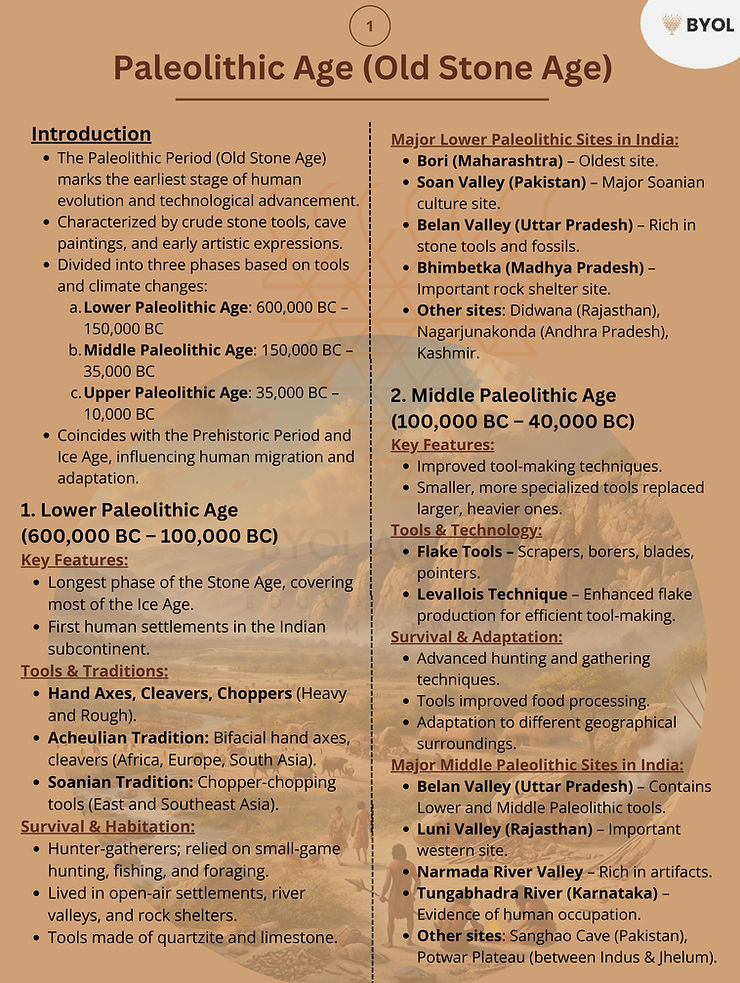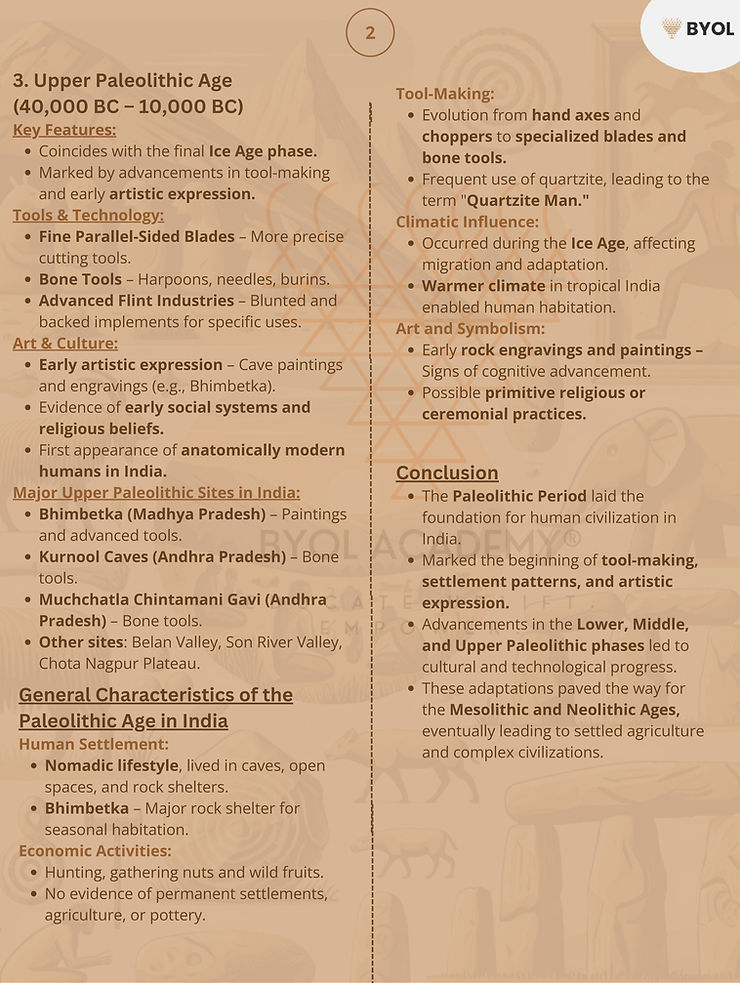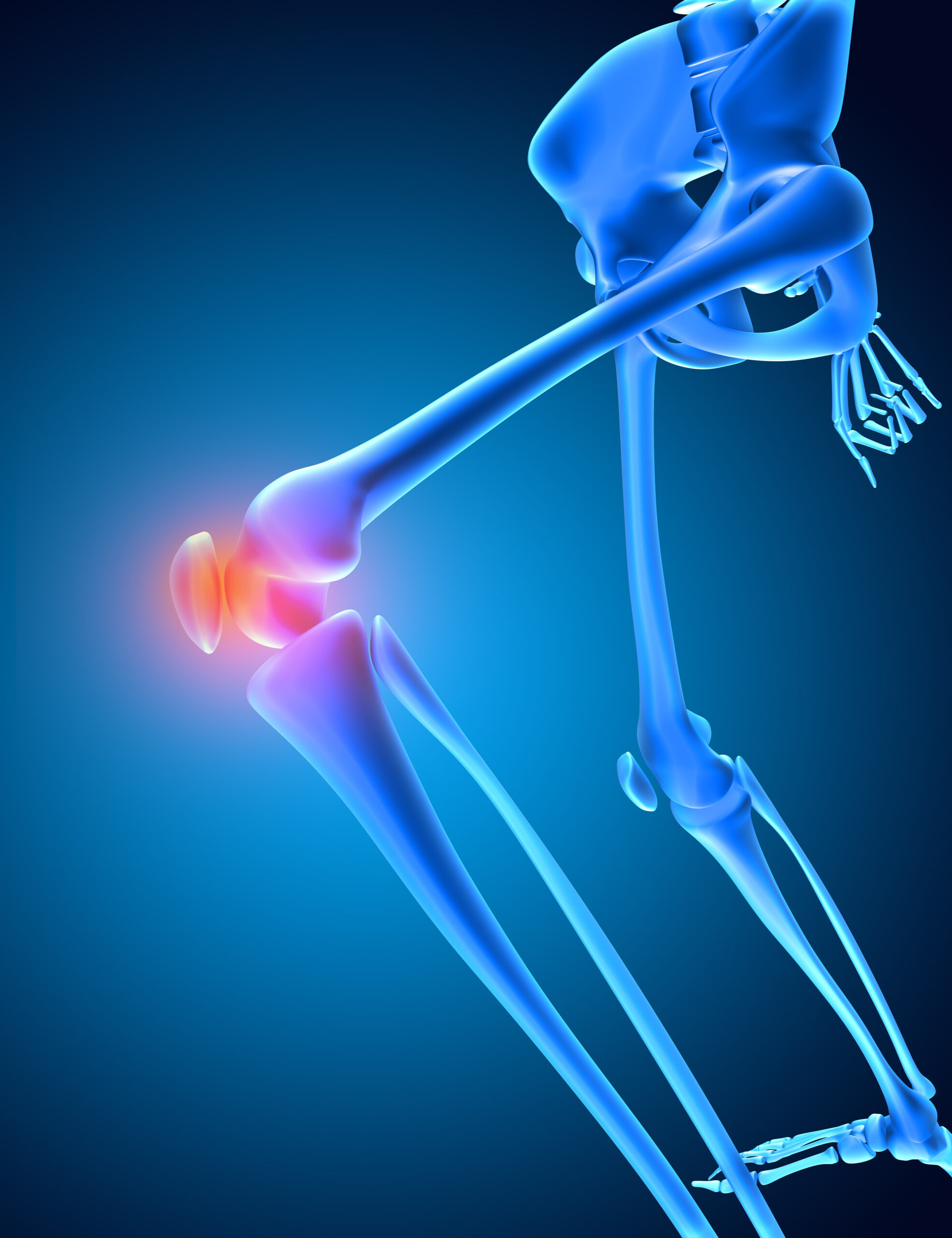Introduction
The ancient stage of human evolution and technological advancement is the Paleolithic Period, sometimes called the Old Stone Age. It is differentiated by early artistic expressions such as cave paintings and carvings, miniature sculptures, and the use of crude tools made of chipped stone. The Paleolithic Age in India is distinguished into three stages according to the kinds of stone tools that were employed and the changes in the climate:
| Lower Paleolithic Age | 600,000 BC – 150,000 BC |
| Middle Paleolithic Age | 150,000 BC – 35,000 BC |
| Upper Paleolithic Age | 35,000 BC – 10,000 BC |
This time frame is equivalent to the Prehistoric period, marked by notable climate variations that affected the migration and evolution of early human populations.
Lower Paleolithic Age (Early Paleolithic Age)- Up to 100,000 BC
The Lower Paleolithic Age is the longest stage of the Stone Age and encompasses the majority of the Ice Phase. The Indian subcontinent’s first human settlements were established there.
Key Features:
- Tools: Hand axes, cleavers, and choppers, which were rough and heavy.
- Traditions:
- Acheulian Tradition: Bifacial hand axes and cleavers, widely found in Africa, Europe, and South Asia.
- Soanian Tradition: Chopper-chopping tools, prevalent in East and Southeast Asia.
- Survival: People were hunters and gatherers, dependent on small-game hunting, fishing, and foraging.
- Habitation: Earlier humans lived in open-air settlements, river valleys, and rock shelters.
- Material: Made of quartzite and limestone.
Major Lower Paleolithic Sites in India:
| Bori (Maharashtra) | Oldest Lower Paleolithic sites in India. |
| Soan Valley (Pakistan) | Major site for the Soanian culture. |
| Belan Valley (Uttar Pradesh) | Rich in stone tools and fossils. |
| Bhimbetka (Madhya Pradesh) | Significant rock shelter site. |
- Didwana (Rajasthan), Nagarjunakonda (Andhra Pradesh), and Kashmir also have notable findings.
Middle Paleolithic Age (100,000 BC – 40,000 BC)
During the Middle Paleolithic Age, the methods for creating tools were improved, and smaller, more specialized tools replaced larger, heavier ones.
Key Features:
- Tools: Flake tools, including scrapers, borers, blades, and pointers.
- Technological advances: Levallois technique for flake production, improving efficiency in tool-making.
- Survival: Early humans relied on hunting and gathering, with improved tool designs aiding in processing food.
- Geographical Choices: Various methods used throughout India indicate adaptation to the surroundings.
Major Middle Paleolithic Sites in India:
| Belan Valley (Uttar Pradesh) | Contains tools from both Lower and Middle Paleolithic phases. |
| Luni Valley (Rajasthan) | Important site in the western region. |
| Narmada River Valley | Rich in Middle Paleolithic artifacts. |
| Tungabhadra River (Karnataka) | Evidence of human occupation. |
- Sanghao Cave (Pakistan) and Potwar Plateau (between Indus & Jhelum) are also significant.
Upper Paleolithic Age (40,000 BC – 10,000 BC)
In the Upper Paleolithic Age, a time frame that coincides with the last stage of the Ice Age, is distinguished by notable developments in tool manufacturing and the earliest indications of creative expression.
Key Features:
- Tools:
- Fine, parallel-sided blades.
- Bone tools such as harpoons, needles, and burins.
- Technological advances: Advanced flint industries developed, with implements blunted and backed for particular purposes.
- Art and Culture:
- Earlier artistic expression is demonstrated by cave paintings and engravings discovered at locations such as Bhimbetka.
- The research points to archaic social systems and religious beliefs.
- Origins of Homo Sapiens: During this time, anatomically modern humans first appeared in India.
Major Upper Paleolithic Sites in India:
| Bhimbetka (Madhya Pradesh) | Contains paintings and advanced tools. |
| Kurnool Caves (Andhra Pradesh) | Significant for bone tools. |
| Muchchatla Chintamani Gavi (Andhra Pradesh) | Another important site for bone tools. |
- Belan Valley, Son River Valley, and Chota Nagpur Plateau also have Upper Paleolithic evidence.
General Characteristics of the Paleolithic Age in India
- Human Settlement:
- They were nomadic people who lived in caves, open spaces, and rock shelters.
- Bhimbetka is one of the major rock shelters, offering protection and a place to live during certain seasons.
- Economic Activities:
- Hunted animals, nuts, and wild fruits were the main sources of sustenance for early people.
- No signs of permanent settlements, agriculture, or ceramics.
- Tool-Making:
- From simple hand axes and choppers to specialised blades and bone tools, tools have changed over time.
- As quartzite was frequently used to make tools, Paleolithic people were referred to as “Quartzite Man.”
- Climatic Influence:
- The Palaeolithic era affected human migration and adaptation since it occurred during the Ice Age.
- Human habitation was made possible by comparatively warmer weather in tropical areas such as India.
- Art and Symbolism:
- Early Paleolithic sites have rock engravings and paintings that demonstrate advances in creativity and cognition.
- Potentially primitive religious or ceremonial practices.






